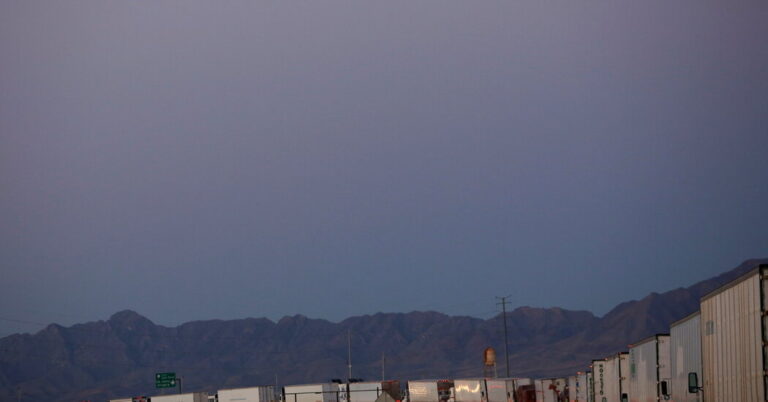Rich Nations Cut Aid for Climate Shocks, Even as Risks Grow
WASHINGTON — Wealthy countries have decreased the amount of money they commit for helping developing countries cope with the effects of climate change, even as the need for that spending has grown, the United Nations said in a report issued on Thursday.
Aid for climate adaptation fell to $21 billion in 2021, the latest year for which comprehensive data is available, a drop of 15 percent from 2020, most likely the result of increased financial pressure on wealthy countries resulting from Covid-19 and other challenges, according to the authors.
The United States posted one of the greatest reductions in climate adaptation aid of any country between 2020 and 2021, the authors found. In 2021, the United States committed $129 million in aid for climate adaptation, compared with $245 million in 2020, a drop of 47 percent.
A White House spokesman, Angelo Fernández Hernández, said the report “does not represent the full picture of what the U.S. is doing on climate adaptation.” He said the Biden administration secured about $2 billion in climate adaptation funding for the 2022 fiscal year.
Developing nations will need between $215 billion and $387 billion annually this decade to protect against climate shocks, such as worsening storms, crop failures and loss of access to water, the report found. That’s as much as 18 times greater than the total amount that wealthy countries committed for climate adaptation in 2021.
The new data comes weeks before the start of a major United Nations climate summit in Dubai, where aid to developing countries will be a top agenda item. At a similar summit two years ago in Glasgow, countries agreed to double their climate adaptation funding by 2025, compared with 2019 levels. Even if nations make good on that pledge, the report said, it would provide just a small share of the additional money needed.
“Ambition really needs to be increased,” said Georgia Savvidou, a research assistant at the Stockholm Environment Institute and one of the authors of the report.
The demand for adaptation assistance has grown. The report notes that under current climate policies around the world, global average temperatures would rise at least 2.4 degrees Celsius, or 4.3 degrees Fahrenheit, compared with preindustrial levels by the end of this century. That’s far more than the 1.5 degrees Celsius that scientists have set as a target, beyond which the effects of warming threaten to become catastrophic.
“Current climate action is woefully inadequate,” the report said.
Since 2016, the last time the United Nations prepared a detailed analysis, the amount of money developing countries need to adapt to climate change has increased by more than 25 percent, according to Paul Watkiss, another author of the report. That growing cost reflects increased global warming and a better understanding of both the effects of that warming and the steps countries must take to address those effects.
The case for climate adaptation aid rests on several core principles, the report said. First, developing nations are responsible for a small share of the greenhouse gas emissions that are causing sea level rise, worsening storms, droughts and other climate shocks. Wealthy nations such as the United States, Germany and the United Kingdom have contributed a disproportionate share of those emissions, which many argue creates an obligation to help deal with their consequences.
Second, poor countries are often more exposed to those shocks than their wealthier counterparts. Their infrastructure is often less modern or well maintained and they may have less access to early warning systems to prepare for disasters, or insurance to rebuild afterward.
Finally, money spent on climate adaptation can greatly reduce the cost of future damages, an argument the Biden administration has used to justify increased adaptation spending within the United States. The infrastructure bill signed by President Biden in 2021 represented the largest single investment in climate resilience and adaptation in American history.
Those returns can be even greater in developing countries. According to the report, $1 billion spent to protect against coastal flooding reduces damages by $14 billion. And investing $16 billion in agriculture each year would save about 78 million people from chronic hunger or starvation.
If developing countries are unable to cope with the effects of climate change, the consequences can also have enormous effects on wealthy countries. Climate-related shocks such as crop failures, hurricanes and other disasters can spur migration, even if the United States and other countries try to prevent it.
“You can’t have fortress Europe,” said Inger Andersen, executive director of the United Nations Environment Program, in an interview last year. “You can’t have fortress America. It doesn’t work.”
Climate shocks can also contribute to instability and conflict. Erin Sikorsky, director of the Center for Climate & Security, a Washington research organization, pointed to Pakistan, a nuclear-armed state that is still suffering from severe flooding last year. The country has seen worsening protests over food and energy prices since those floods, she said.
“Climate-driven instability in countries like Pakistan threatens U.S. security, whether by spiraling into conflict that requires the deployment of U.S. troops, or giving extremists a foothold to exploit popular unrest and expand their power,” Ms. Sikorsky said.
The report notes another way in which assistance from wealthy nations is falling short: Only two-thirds of the $21 billion that wealthy nations promised in 2021 has actually been disbursed.
“We cannot have impact on the ground unless finance is actually reaching the ground,” Ms. Savvidou said.
Check out our Latest News and Follow us at Facebook
Original Source







